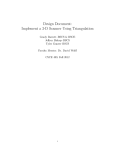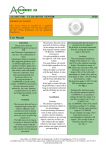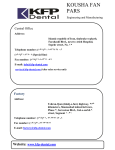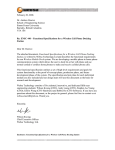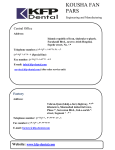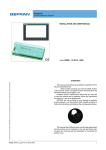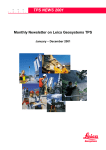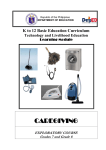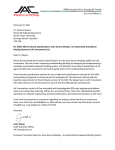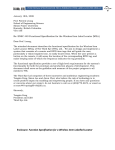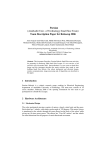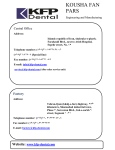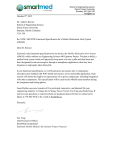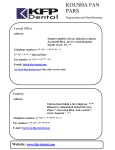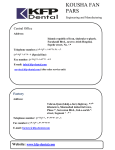Download Vedo Medico - School of Engineering Science
Transcript
Vedo Medico Functional Specification for EMS February 20, 2006 Dr. Andrew Rawicz School of Engineering Science Simon Fraser University Burnaby, British Columbia V5A 1S6 Re: ENSC 440 Functional Specifications for Edema Measurement System Dear Dr. Rawicz: The attached document, Functional Specifications for Edema Measurement System (EMS), outlines the functional requirements for our ENSC 440 project. Vedo Medico’s prototype, Edema Measurement System, is being designed to provide medical professionals with an easy to use device to accurately measure the amount of swelling of limbs in patients. The purpose of this document is to outline the requirements that EMS will meet upon completion of the working prototype. In addition, other functional requirements pertaining to future prototypes are specified in the documents. The overall system requirements, user documentation requirements and product test plans are provided. Vedo Medico consists of five talented fourth year Systems engineering students: Ali Khan, Sepehr Mogharei, Arthur Papian-Gorji, Babak Shafiei, and Branko Zdravkovic. Please feel free to contact us with any questions or concerns regarding our project. We can be reached by telephone at 778-885-6059, or by email at [email protected]. Sincerely, Babak Shafiei Babak Shafiei VP Operations Vedo Medico Enclosed: Functional Specifications for Edema Measurement System (EMS) Copyright © 2006, Vedo Medico 1 Vedo Medico Functional Specification: Edema Measurement System Project team: Ali Khan Sepehr Mogharei Arthur Papian-Gorji Babak Shafiei Branko Zdravkovic Contact person: Babak Shafiei Submitted to: [email protected] Dr. Andrew Rawicz Steve Whitmore Issue date: Revision: February 20, 2006 1.0 Vedo Medico Functional Specification for EMS Executive Summary If you can’t prevent a disease, the next best thing you can do to protect your health is to detect the symptoms of a disease early. Build-up of excess fluids in body tissues (edema) is one of the major signs of heart failure. This early sign of heart failure can easily be detected by monitoring the amount of swelling in a patient’s leg. Constant monitoring of the swelling of various limbs can provide medical professionals with key information for proper diagnosis. Vedo Medico’s Edema Measurement System provides a non-invasive and accurate measurement of edema in the patient’s limbs. The Edema Measurement System is designed with the user in mind. EMS presents users with reliable information through an easy to use interface. With that in mind, the production of EMS will be completed in two phases: a proof-of-concept phase and a final production phase. Upon completion of the primarily proof-of-concept phase, the Edema Measurement System will support the following features: • Ability to measure and track amount of swelling in patient’s limbs • Ability to operate using an AC adaptor or replaceable battery • Easy to use user interface Other key requirements for the proof-of-concept model of the EMS device are outlined in the document. In addition, features pertaining to the final production phase, user documentation and support requirements, and test plans are also provided. The 13 week cycle of the proof-of-concept phase is projected for completion by April 2006. Copyright © 2006, Vedo Medico 2 Vedo Medico Functional Specification for EMS CONTENTS Executive Summary ................................................................................................................................ 2 GLOSSARY............................................................................................................................................. 4 1 Introduction.................................................................................................................................... 5 1.1 1.2 1.3 2 Scope....................................................................................................................................... 5 Intended Audience................................................................................................................ 5 Classification.......................................................................................................................... 5 System Requirements .................................................................................................................... 6 2.1 2.2 2.3 2.3.1 2.3.2 2.4 2.5 2.6 2.7 2.8 2.9 2.10 2.11 2.12 System Overview................................................................................................................... 6 General Requirements.......................................................................................................... 8 Physical Requirements.......................................................................................................... 8 Enclosure System............................................................................................................................. 8 Control Unit................................................................................................................................... 8 Electrical Requirements ....................................................................................................... 9 Environmental Requirements ............................................................................................. 9 Standards ................................................................................................................................ 9 Reliability and Durability...................................................................................................... 9 Safety Requirements ........................................................................................................... 10 Performance Requirements ............................................................................................... 10 Usability Requirements ...................................................................................................... 10 User Interface Requirements............................................................................................. 10 Luxury Requirements ......................................................................................................... 11 3 User Documentation and Support ............................................................................................ 12 4 System Test Plan .......................................................................................................................... 13 5 Conclusion .................................................................................................................................... 15 6 References ..................................................................................................................................... 15 LIST OF FIGURES Figure 2.1 EMS System Overview ........................................................................................ 6 Figure 2.2 Interaction between user and peripheral devices.................................................. 7 Copyright © 2006, Vedo Medico 3 Vedo Medico Functional Specification for EMS GLOSSARY AC Alternating Current CU Control Unit Edema Swelling caused by excess fluids in body tissue. EMS Edema Measurement System ES Enclosure System FAQ Frequently Asked Questions GUI Graphical User Interface IEC International Electrotechnical Commission MTBF Mean Time Between Failures PC Personal Computer Copyright © 2006, Vedo Medico 4 Vedo Medico Functional Specification for EMS 1 Introduction 1.1 Scope This document outlines the functional requirements for Vedo Medico’s proposed Edema Measurement System. A complete set of requirements pertaining to the proofof-concept model and future versions are provided. User documentation requirements and system test plans are also included. The requirements provided will aid in the design process by insuring the working prototype meets the needs of its users. 1.2 Intended Audience This document is intended for Vedo Medico’s design engineers, project managers, sales and marketing personnel, and potential customers. Design engineers will use the document as a guideline during the development process of EMS. Project managers can use the document as a project milestone guideline and as a benchmark to verify device integrity. Marketing personnel will use current document for initial marketing and promotional material. Potential customers can use the outlined requirements to foresee the functionality that the EMS prototype will meet. 1.3 Classification The following convention shall be used throughout this document to denote functional requirements: [R#-p] A functional specification requirement. Where # is the functional requirement identification number, and p is the priority of the functional requirement which can be any of the following values: I Requirement is applicable to the proof-of-concept system only. II Requirement is applicable to the final production system only. III Requirement is applicable to both the proof-of-concept system and the final production system. Copyright © 2006, Vedo Medico 5 Vedo Medico Functional Specification for EMS 2 System Requirements General functional requirements of the EMS diagnostics device are presented in the following sections. 2.1 System Overview The main function of the EMS device is to detect the change in volume of the lower part of the leg caused by edema, which could be a potential symptom of health risks such as heart disease and kidney failure. The high level model of the functional operation of the EMS is shown in Figure 2.1. PC Diagnostic System EMS ES EMS CU User Patient Figure 2.1 - EMS System Overview The EMS device will consist of two main functional components. The EMS Enclosure System (ES) will function as the measuring subpart; sending results to the EMS CU, which itself could be interfaced to the PC GUI and diagnostics software. The user would be able to directly interact with the EMS Control Unit (CU), and will have access to the diagnostics results on the PC software. Figure 2.2 shows the interaction between user and peripheral devices. Copyright © 2006, Vedo Medico 6 Vedo Medico Functional Specification for EMS 2. EMS ES 4. PC & Diagnostics Software 1. Lower Leg of the patient 3. EMS CU 5. User Figure 2.2 - Interaction between user and peripheral devices The EMS CU unit will store sufficient data for a set number of patients on the data memory unit. The measurement data can be transferred to a PC based software capable of handling the results and storing results in a larger database. The user would be able to retrieve and analyze instantaneous results directly from the EMS CU, and make comparative analysis with previously taken measurements stored on the PC based diagnostics software. At the health professional end, the Edema Measurement System will handle data storage, processing and measurement display. Health professionals will use this information to perform the actual patients’ follow-ups; therefore, accuracy and reliability of this information are key. Copyright © 2006, Vedo Medico 7 Vedo Medico Functional Specification for EMS 2.2 General Requirements [R1 - III] The Enclosure System shall be wearable on the lower part of a human leg with a secure and comfortable fit. [R2 - III] The Enclosure System shall be adjustable so as to fit most human leg sizes. [R3 - II] The device should be easy to carry and comfortable in the operator’s hands. [R4 - II] [R5 - II] The Enclosure System should be washable by disconnecting the component from the CU. The retail price for the EMS device should be less than $150 per unit. [R6 - II] The production cost for the EMS device should be less than $75 per unit. 2.3 Physical Requirements Edema Measurement System will consist of two major components: Enclosure System and Control Unit (CU). The Enclosure System will wrap around the patient’s limb, while the CU will contain the user interface. 2.3.1 Enclosure System [R7 - III] The diameter of the limb enclosure should be less than 50 cm. [R8 - III] The width of the Enclosure System should be smaller than 30 cm. [R9 - II] The Enclosure System shall weight no more than 400 grams. [R10 - III] The Enclosure System shall be soft and flexible in the inside layer and hard and solid on the outside. [R11 - II] The edges of the device should be soft and comfortable to the skin. [R12 - III] Enclosure should be able to hold at least 5 psi of an inert gas. 2.3.2 Control Unit [R13 - III] The height of the CU shall be no longer than 20 cm. [R14 - III] The width of the CU shall be no longer than 10 cm. [R15 - II] The CU shall have an ergonomic shape and be easy to handle by the user. [R16 - II] The CU shall weight no more than 500 grams. [R17 - II] The cord connecting the CU to the Enclosure System should be at least 2m long. [R18 - II] The mechanical components of the device shall not be visually or physically obtrusive. Copyright © 2006, Vedo Medico 8 Vedo Medico Functional Specification for EMS 2.4 Electrical Requirements [R19 - III] The device shall be able to operate on standard 120V AC (60Hz) power outlets. [R20 - III] The device shall be capable of operating using a replaceable battery. [R21 - II] The replaceable battery should be able to sustain power for at least 2 weeks. [R22 - III] The device should have an auto-shutoff functionality to avoid wasting battery power. 2.5 Environmental Requirements [R23 - III] The device should be able to operate normally under typical office/hospital temperature range of 10ºC – 50ºC. [1] [R24 - II] The device should be able to operate normally in altitudes ranging from sea level to 2,000m. [R25 - III] The device should be able to operate normally under typical office/hospital environment with relative humidity ranging between 30% - 60%. [1] [R26 - III] The device should not be constructed from any material that will be corrosive or harmful to the environment. [R27 - II] The device should be water resistant. 2.6 Standards [R28 - III] The device will conform to UL Standards of Safety for electrical devices. [2] [R29 - III] The device will conform to CSA requirements for electrical devices: CAN/CSA-C22.2 NO. 0-M91 (R2001). [3] [R30 - III] The device will conform to CSA requirements for medical measurement equipment: CAN/CSA-C22.2 NO. 1010.2.041-96 (R2004). [4] [R31 - III] The device will conform to IEC60601-1-4 Programmable Electrical Medical Systems Standards. [5] 2.7 Reliability and Durability [R32 - II] The device needs to provide at least 50,000 measurements without Enclosure System replacement. [R33 - II] The device should withstand a 2m vertical fall. [R34 - III] The expected lifespan of the device should be greater than 5 years. [R35 - II] All pressure measurement devices require regular calibration. Calibration for the EMS subjected to intensive use should be repeated every 2 years. [6] [R36 - III] The warranty period will be 2 years and if any sub system of the device malfunctions during this time the device should be sent to the manufacturer for repair/replacement. [R37 - III] MTBF of EMS CU and sensors should be no less than 2000 hours. Copyright © 2006, Vedo Medico 9 Vedo Medico Functional Specification for EMS 2.8 Safety Requirements [R38 - III] The gas filled Enclosure System will be made of a non-allergic material in order to prevent complications due to allergic reactions from being in contact with the patient’s skin. [R39 - II] The electronic subsystem of the device will be sealed in water-resistant material so the user is protected from electrical shock and physical injuries. [R40 - II] The safety valve will prevent pressurizing the Enclosure System to more than 2 atmospheres. [R41 - II] The device should not contain any sharp edges that could harm the patient. 2.9 Performance Requirements [R42 - III] The device should be able to power-up in less than 2 seconds. [R43 - III] The device should calculate and display the measured value within 5 seconds. [R44 - III] The device should have a measurement resolution of ±1 ml. [R45 - III] The Enclosure System should not dislocate or over pressurize the edema, changing the shape and volume of the limb being measured. 2.10 Usability Requirements [R46 - III] The digital display should be large and easily readable. [R47 - III] The device should be powered up by the press of a single button. [R48 - III] The user should be able to take a measurement with a single button press to allow for simple and foolproof operation of the device. [R49 - II] The device will have a power on self test that will prevent taking measurements if the Enclosure System is over/under-inflated. 2.11 User Interface Requirements [R50 - III] The CU should consist of a small display screen mounted along with buttons; these will allow users to navigate through menus and take measurements easily with visual feedback. [R51 - III] The measured data will be shown on the display for a maximum of 30 seconds to allow sufficient viewing time; the user will be able to store the data or redo the measurement during this time. [R52 - III] Capable of scrolling through previously measured patient data in chronological order so users can view the change in swelling over time. [R53 - III] The display will be capable of scrolling lines of text horizontally to overcome limitations in small display size (i.e. display longer lines of text). [R54 - III] The device will be able to display measurements in either metric or imperial units through the use of a switch to accommodate for users with varying measurement practices. Copyright © 2006, Vedo Medico 10 Vedo Medico Functional Specification for EMS 2.12 Luxury Requirements [R55 - II] A universal enclosure to suit all leg circumferences should be provided. [R56 - II] The device should be able to give an audible output of the measurement. [R57 - II] Users will be able to assign measurements and accompanying measurement dates to a patient ID entered via the CU. [R58 - II] The user will be able to store measurements to a patient’s file in the device, and synchronize this data with a PC via an accessible wired connection. This will allow the user to analyze the data using a PC. [R59 - II] Patient name and data can be updated offline on a PC and then synchronized to the device so that lengthy names or patient ID’s can be entered easily with a keyboard. Copyright © 2006, Vedo Medico 11 Vedo Medico Functional Specification for EMS 3 User Documentation and Support The intended users of the Edema Measurement System will be medical professionals in health care facilities. In order to assist the users of EMS device during the learning and troubleshooting stage, the user documentation and support should meet the following requirements. [R60 - III] The user manual provided will be written in English. [R61 - II] The user manual provided will be written in English, French, German, Japanese and Spanish. [R62 - I] The user manual will be written for users with minimal knowledge of technical/electrical devices. [R63 - III] The user manual will contain a step-by-step guide on using the EMS device. [R64 - I] The user manual will contain a FAQ, troubleshooting, device specification, and safety section. [R65 - I] The user manual will contain device warranty and copyright information. [R66 - II] The company website will contain device description, device specification, online user manual, support forum, and company profile section. [R67 – II] Additional firmware upgrades will be provided for the user through the company website. [R68 – II] Additional user support will be provided via email and by phone. [R69 – I] Minimal user training should be needed for operating the device. [R70 – I] Training for end user will be provided by project developers. [R71 - II] Training for end user will be provided via user manual, email and by phone. [R72 - II] The recommended time period between calibrations should be clearly labeled on the device. Copyright © 2006, Vedo Medico 12 Vedo Medico Functional Specification for EMS 4 System Test Plan An essential part of a product test is a well designed test plan. A test without a plan would only be considered an experiment. Test cases should be developed based on the data analysis, and the software operation. These tests should be conducted to demonstrate: • Correctness and completeness with respect to the accuracy for the programmable component. • That malfunctions caused by data handling errors and control errors. • Consistency in data and control flows in the device Failure and stress testing should be conducted to verify that the software responds correctly and without resulting in any invalid data. These tests should include consideration of the following: • Operator errors that could cause malfunction of the programmable component • Hardware component faults The proposed test plans for the EMS will include event, stress, environmental, and time reliability tests. EVENT TESTING Event testing shall be performed under standard conditions, at ambient temperature and typical operation parameters. [T1] The gas filled EMS ES shall be tested for gas leakage in terms of the number of operation cycles. STRESS TESTING [T2] Mechanical stress analysis shall be performed to ensure the proper operation of the EMS after it has been dropped form 2m altitude. [T3] Elasticity of the ES shall be tested in order to ensure the proper fit and that the device doesn’t break under excessive usage conditions. ENVIRONMENTAL TESTING [T4] Thermal shock testing will be performed under different temperature ranges below 10 °C and above 35 °C Copyright © 2006, Vedo Medico 13 Vedo Medico Functional Specification for EMS [T5] Operating temperature testing shall be performed to ensure that the device still operates accurately in the normal operating temperature range of 10°C - 35°C. [T6] Mechanical shock tests shall be performed to assure the device will withstand stresses of shipping, handling, and day to day use. [T7] The accuracy of the EMS will be tested in a relative humidity range of 30%-60%. TIME RELIABILITY TESTING [T8] Time reliability testing will be performed to determine MTBF of EMS CU and Sensors. [T9] Failure analysis shall be performed to determine the mechanism of failure in order to take necessary steps to reduce the chance of future occurrences. Copyright © 2006, Vedo Medico 14 Vedo Medico Functional Specification for EMS 5 Conclusion The functional specifications outlined in this document clearly define features that can be anticipated in the proof-of-concept and final production model of the Edema Measurement System. The design of the proof-of-concept model is well underway and upon completion of the product in April 2006, all requirements pertaining to the proofof-concept model will be met. Meeting the above requirements will ensure that Vedo Medico’s product will be effective and reliable. 6 References [1] National Research Council of Canada, “Indoor Air Quality and Thermal Comfort in OpenPlan Offices” October 2005, http://irc.nrc-cnrc.gc.ca/pubs/ctus/64_e.html [2] Underwriters Laboratories Inc., “Standards” February 2006, http://www.ul.com. [3] Canadian Standards Association, “Canadian Electrical Code” February 2006, http://www.csa.ca/electronic_catalogue/electrical.pdf. [4] Canadian Standards Association, “Canadian Electrical Code Part II-General Requirements” February 2005, http://www.csa-intl.org/onlinestore/GetCatalogDrillDown.asp?Parent=1302. [5] International Electrotechnical Commission, “General Standards for Medical Devices” February 2006, http://www.doctordevice.com/genstds.html. [6] Lippincott Williams & Wilkins, “Special Article” March 2005, http://www.dableducational.com/pdfs/spring05/BP_devices_for_low_resource_setti ngs_BPMonit_Mar_2005.pdf [7] “Medical Device Reliability And Associated Areas”, B.S. Dhillon, Ph.D., 2000. [8] “Handbook of Reliability Engineering And Management”, W. Grant Ireson, 1996. Copyright © 2006, Vedo Medico 15

















